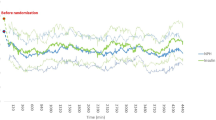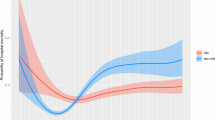Abstract
Introduction
Tight glycemic control (TGC) after ischemic stroke may improve clinical outcome but previous studies failed to establish TGC, principally because of postprandial glucose surges. The aim of the present study was to investigate if safe, effective and feasible TGC can be achieved with continuous tube feeding and a computerized treatment protocol.
Methods
We subjected ten acute ischemic stroke patients with admission hyperglycemia (glucose >7.0 mmol/l (126.0 mg/dl)) to continuous tube feeding and a computerized intensive protocol with insulin adjustments every 1–2 h. Two groups of regularly fed patients from a previous study with a similar design served as controls. These groups comprised hyperglycemic patients treated according to an intermediate protocol with insulin adjustments at standard intervals (N = 13), and normoglycemic controls treated according to standard care (N = 15). The primary outcome was the percentage of time within target (4.4–6.1 mmol/l (79.2–109.8 mg/dl)). Secondary outcome was the number of patients with hypoglycemic episodes (glucose <3.0 mmol/l (54.0 mg/dl)).
Results
Median time within target was 55% in the continuously fed intensive group compared to 19% in the regularly fed intermediate group, and 58% in normoglycemic controls. Hypoglycemic episodes occurred in 20% of patients in the continuously fed group—lowest glucose level 2.4 mmol/l (43.2 mg/dl). In contrast, in the regularly fed group, this was 31%—lowest glucose level 1.6 mmol/l (28.8 mg/dl).
Conclusions
TGC after acute ischemic stroke is feasible with continuous tube feeding and a computerized intensive treatment protocol. Although glycemic control is associated with hypoglycemia, no severe hypoglycemia occurred in the continuous tube feeding group.

Similar content being viewed by others
References
Baird TA, Parsons MW, Phanh T, Butcher KS, Desmond PM, Tress BM, et al. Persistent poststroke hyperglycemia is independently associated with infarct expansion and worse clinical outcome. Stroke. 2003;34:2208–14. doi:10.1161/01.STR.0000085087.41330.FF.
Capes SE, Hunt D, Malmberg K, Pathak P, Gerstein HC. Stress hyperglycemia and prognosis of stroke in nondiabetic and diabetic patients: a systematic overview. Stroke. 2001;32:2426–32. doi:10.1161/hs1001.096194.
Chalela JA, Merino JG, Warach S. Update on stroke. Curr Opin Neurol. 2004;17:447–51. doi:10.1097/01.wco.0000137536.06986.f9.
Els T, Klisch J, Orszagh M, Hetzel A, Schulte-Monting J, Schumacher M, et al. Hyperglycemia in patients with focal cerebral ischemia after intravenous thrombolysis: influence on clinical outcome and infarct size. Cerebrovasc Dis. 2002;13:89–94. doi:10.1159/000047756.
Parsons MW, Barber PA, Desmond PM, Baird TA, Darby DG, Byrnes G. Acute hyperglycemia adversely affects stroke outcome: a magnetic resonance imaging and spectroscopy study. Ann Neurol. 2002;52:20–8. doi:10.1002/ana.10241.
Yong M, Kaste M. Dynamic of hyperglycemia as a predictor of stroke outcome in the ECASS-II trial. Stroke. 2008;39(10):2749–55. doi:10.1161/STROKEAHA.108.514307.
Krinsley JS. Effect of an intensive glucose management protocol on the mortality of critically ill adult patients. Mayo Clin Proc. 2004;79:992–1000. doi:10.4065/79.8.992.
van den Berghe WA, Hermans G, Meersseman W, Wouters PJ, Milants I. Intensive insulin therapy in the medical ICU. N Engl J Med. 2006;354:449–61. doi:10.1056/NEJMoa052521.
van den Berghe WA, Milants I, Wouters PJ, Bouckaert B, Bruyninckx F. Intensive insulin therapy in mixed medical/surgical intensive care units: benefit versus harm. Diabetes. 2006;55:3151–9. doi:10.2337/db06-0855.
Wiener RS, Wiener DC, Larson RJ. Benefits and risks of tight glucose control in critically ill adults: a meta-analysis. JAMA. 2008;300:933–44. doi:10.1001/jama.300.8.933.
Finfer S, Chittock DR, Su SY, Blair D, Foster D, Dhingra V. Intensive versus conventional glucose control in critically ill patients. N Engl J Med. 2009;360:1283–97. doi:10.1056/NEJMoa0810625.
Griesdale DE, de Souza RJ, van Dam RM, Heyland DK, Cook DJ, Malhotra A. Intensive insulin therapy and mortality among critically ill patients: a meta-analysis including NICE-SUGAR study data. CMAJ. 2009.
Latorre JG, Chou SH, Nogueira RG, Singhal AB, Carter BS, Ogilvy CS. Effective glycemic control with aggressive hyperglycemia management is associated with improved outcome in aneurysmal subarachnoid hemorrhage. Stroke. 2009.
Garg R, Chaudhuri A, Munschauer F, Dandona P. Hyperglycemia, insulin, and acute ischemic stroke: a mechanistic justification for a trial of insulin infusion therapy. Stroke. 2006;37:267–73. doi:10.1161/01.STR.0000195175.29487.30.
Martini SR, Kent TA. Hyperglycemia in acute ischemic stroke: a vascular perspective. J Cereb Blood Flow Metab. 2007;27:435–51. doi:10.1038/sj.jcbfm.9600355.
Gray CS, Hildreth AJ, Sandercock PA, O’Connell JE, Johnston DE, Cartlidge NE. Glucose–potassium–insulin infusions in the management of post-stroke hyperglycaemia: the UK Glucose Insulin in Stroke Trial (GIST-UK). Lancet Neurol. 2007;6:397–406. doi:10.1016/S1474-4422(07)70080-7.
Langouche L, Vanhorebeek I, van den Berghe G. Therapy insight: the effect of tight glycemic control in acute illness. Nat Clin Pract Endocrinol Metab. 2007;3:270–8. doi:10.1038/ncpendmet0426.2004;114:1187-95.
van den Berghe G. How does blood glucose control with insulin save lives in intensive care? J Clin Invest. 2004;114:1187–95.
Bruno A, Saha C, Williams LS, Shankar R. IV insulin during acute cerebral infarction in diabetic patients. Neurology. 2004;62:1441–2.
Hassan E. Hyperglycemia management in the hospital setting. Am J Health Syst Pharm. 2007;64:S9–14. doi:10.2146/ajhp070102.
McCormick MT, Muir KW, Gray CS, Walters MR. Management of hyperglycemia in acute stroke: how, when, and for whom? Stroke. 2008;39:2177–85. doi:10.1161/STROKEAHA.107.496646.
Vriesendorp TM, Roos YBWEM, Kruyt ND, Biessels GJ, Kappelle LJ, Vermeulen M. Efficacy and safety of two 5-day insulin dosing regimens to achieve strict glycemic control in patients with acute ischemic stroke. J Neurol Neurosurg Psychiatry. 2009 (in press).
Walters MR, Weir CJ, Lees KR. A randomised, controlled pilot study to investigate the potential benefit of intervention with insulin in hyperglycaemic acute ischaemic stroke patients. Cerebrovasc Dis. 2006;22:116–22. doi:10.1159/000093239.
Kreisel SH, Berschin UM, Hammes HP, Leweling H, Bertsch T, Hennerici MG. Pragmatic management of hyperglycaemia in acute ischaemic stroke: safety and feasibility of intensive intravenous insulin treatment. Cerebrovasc Dis. 2009;27:167–75. doi:10.1159/000185608.
Bruno A, Kent TA, Coull BM, Shankar RR, Saha C, Becker KJ. Treatment of Hyperglycemia in Ischemic Stroke (THIS). A randomized pilot trial. Stroke. 2007.
Johnston KC, Li JY, Lyden PD, Hanson SK, Feasby TE, Adams RJ. Medical and neurological complications of ischemic stroke: experience from the RANTTAS trial. RANTTAS investigators. Stroke. 1998;29:447–53.
O’Neill PA, Davies I, Fullerton KJ, Bennett D. Stress hormone and blood glucose response following acute stroke in the elderly. Stroke. 1991;22:842–7.
Christensen H, Boysen G, Johannesen HH. Serum-cortisol reflects severity and mortality in acute stroke. J Neurol Sci. 2004;217:175–80. doi:10.1016/j.jns.2003.09.013.
Vancheri F, Curcio M, Burgio A, Salvaggio S, Gruttadauria G, Lunetta MC. Impaired glucose metabolism in patients with acute stroke and no previous diagnosis of diabetes mellitus. QJM. 2005;98:871–8. doi:10.1093/qjmed/hci134.
Kernan WN, Viscoli CM, Inzucchi SE, Brass LM, Bravata DM, Shulman GI. Prevalence of abnormal glucose tolerance following a transient ischemic attack or ischemic stroke. Arch Intern Med. 2005;165:227–33. doi:10.1001/archinte.165.2.227.
Braithwaite SS. Inpatient insulin therapy. Curr Opin Endocrinol Diabetes Obes. 2008;15:159–66.
Hermayer KL, Neal DE, Hushion TV, Irving MG, Arnold PC, Kozlowski L. Outcomes of a cardiothoracic intensive care web-based online intravenous insulin infusion calculator study at a Medical University Hospital. Diabetes Technol Ther. 2007;9:523–34.
Cordingley JJ, Vlasselaers D, Dormand NC, Wouters PJ, Squire SD, Chassin LJ. Intensive insulin therapy: enhanced model predictive control algorithm versus standard care. Intensive Care Med. 2009;35:123–8. doi:10.1007/s00134-008-1236-z.
Hovorka R, Kremen J, Blaha J, Matias M, Anderlova K, Bosanska L. Blood glucose control by a model predictive control algorithm with variable sampling rate versus a routine glucose management protocol in cardiac surgery patients: a randomized controlled trial. J Clin Endocrinol Metab. 2007;92:2960–4. doi:10.1210/jc.2007-0434.
Plank J, Blaha J, Cordingley J, Wilinska ME, Chassin LJ, Morgan C. Multicentric, randomized, controlled trial to evaluate blood glucose control by the model predictive control algorithm versus routine glucose management protocols in intensive care unit patients. Diabetes Care. 2006;29:271–6. doi:10.2337/diacare.29.02.06.dc05-1689.
Brunkhorst FM, Engel C, Bloos F, Meier-Hellmann A, Ragaller M, Weiler N. Intensive insulin therapy and pentastarch resuscitation in severe sepsis. N Engl J Med. 2008;358:125–39. doi:10.1056/NEJMoa070716.
de Courten-Meyers, Kleinholz M, Wagner KR, Myers RE. Normoglycemia (not hypoglycemia) optimizes outcome from middle cerebral artery occlusion. J Cereb Blood Flow Metab. 1994;14:227–36.
Zhu CZ, Auer RN. Optimal blood glucose levels while using insulin to minimize the size of infarction in focal cerebral ischemia. J Neurosurg. 2004;101:664–8.
Chase JG, Shaw GM. Is there more to glycaemic control than meets the eye? Crit Care. 2007;11:160. doi:10.1186/cc6099.
Hovorka R. The future of continuous glucose monitoring: closed loop. Curr Diabetes Rev. 2008;4:269–79. doi:10.2174/157339908785294479.
Wong AA, Schluter PJ, Henderson RD, O’Sullivan JD, Read SJ. Natural history of blood glucose within the first 48 hours after ischemic stroke. Neurology. 2008;70:1036–41. doi:10.1212/01.wnl.0000306635.08410.68.
Author information
Authors and Affiliations
Corresponding author
Rights and permissions
About this article
Cite this article
Kruyt, N.D., Biessels, G.J., Vriesendorp, T.M. et al. Subjecting Acute Ischemic Stroke Patients to Continuous Tube Feeding and an Intensive Computerized Protocol Establishes Tight Glycemic Control. Neurocrit Care 12, 62–68 (2010). https://doi.org/10.1007/s12028-009-9230-z
Received:
Accepted:
Published:
Issue Date:
DOI: https://doi.org/10.1007/s12028-009-9230-z




